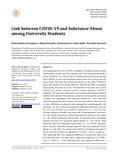| dc.description.abstract | The ongoing spread of the COVID-19 pandemic has exposed much systemic vulnerability to health care, the economy, and to the normal functioning of society worldwide. As a result of the accumulating stress, many young people find it difficult to cope with mounting pressure and revert to drug and substance abuse. There has been increased research on the impact COVID-19 had on the normal lives of people. However, studies of this effect on substance abuse among the youth are scarce. The objective of the study was to assess substance use disorders among university students during the COVID-19 pandemic. The study was a descriptive cross-sectional study and Quantitative methods were adopted. The study was carried out in three public universities in Kenya. The respondents were university students (n = 278). Data were analyzed through descriptive statistics and one-way ANOVA which was used to check differences in substance abuse amongst the sociodemographic characteristics. In case of observing significant differences Bonferroni post-hoc test was used. Findings were considered significant at p < 0.05. The main outcome measures included drug abuse and sociodemographic characteristics. The overall computation revealed that generally majority of the student (n = 157, 56.5%) moderately abused drugs. The majority of the respondents reported that they very frequently abused alcohol (n = 152, 54.7%). Many noted that they very frequently abused miraa (n = 133, 47.8%). Moreover, many reported frequently abusing cigarettes; they less frequently abused Bhang (n = 138, 49.6). The results of the ANOVA revealed that the main effect for the year of study was significant, F (3, 266) = 3.86, p = 0.010, ηp2 = 0.04, indicating there were significant differences in Drug abuse mean score by study year levels. The main effect, religion was significant, F (3, 266) = 3.65, p = 0.013, ηp2 = 0.04, indicating there were significant differences in Drug abuse mean score by Religion levels. The main effect, University was significant, F (2, 266) = 22.72, p < 0.001, ηp2 = 0.15, indicating there were significant differences in Drug abuse mean score by university levels. The main effect, area of origin, gender and marital status were not significant. In conclusion, although the findings show that the abuse of drugs and substances was moderate during the COVID-19 pandemic period, alcohol and miraa abuse were still high among university students during the same period. The study recommends that investing extensively in support programs and making them necessary should be essential for tertiary schools in order to help students develop the necessary life skills, healthy leisure activities that decrease stress and sadness, as well as the dangers of drug use and addictions, it is essential to engage them during their spare time. | en_US |

